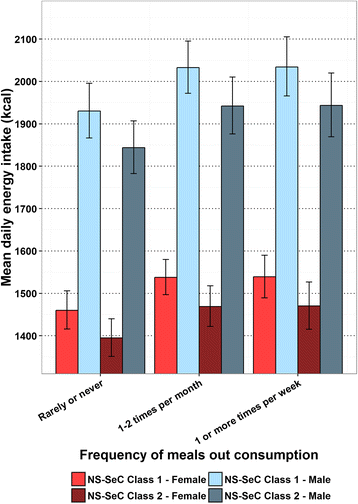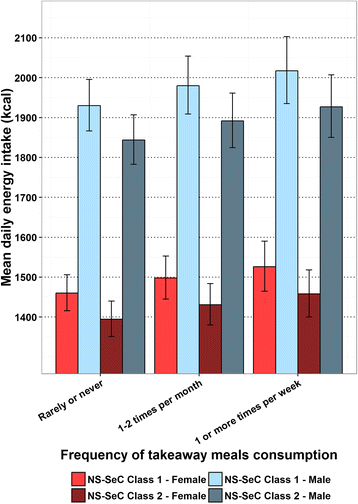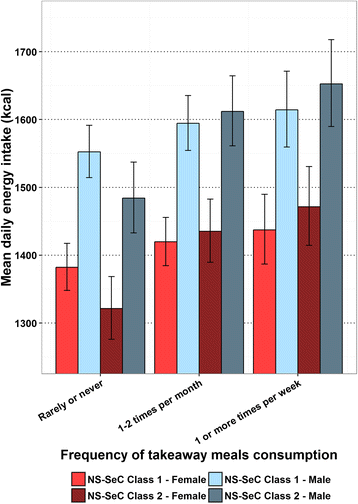Relationship between mean daily energy intake and frequency of consumption of out-of-home meals in the UK National Diet and Nutrition Survey
- PMID: 28938893
- PMCID: PMC5610411
- DOI: 10.1186/s12966-017-0589-5
Relationship between mean daily energy intake and frequency of consumption of out-of-home meals in the UK National Diet and Nutrition Survey
Abstract
Background: Out-of-home meals have been characterised as delivering excessively large portions that can lead to high energy intake. Regular consumption is linked to weight gain and diet related diseases. Consumption of out-of-home meals is associated with socio-demographic and anthropometric factors, but the relationship between habitual consumption of such meals and mean daily energy intake has not been studied in both adults and children in the UK.
Methods: We analysed adult and child data from waves 1-4 of the UK National Diet and Nutrition Survey using generalized linear modelling. We investigated whether individuals who report a higher habitual consumption of meals out in a restaurant or café, or takeaway meals at home had a higher mean daily energy intake, as estimated by a four-day food diary, whilst adjusting for key socio-demographic and anthropometric variables.
Results: Adults who ate meals out at least weekly had a higher mean daily energy intake consuming 75-104 kcal more per day than those who ate these meals rarely. The equivalent figures for takeaway meals at home were 63-87 kcal. There was no association between energy intake and frequency of consumption of meals out in children. Children who ate takeaway meals at home at least weekly consumed 55-168 kcal more per day than those who ate these meals rarely. Additionally, in children, there was an interaction with socio-economic position, where greater frequency of consumption of takeaway meals was associated with higher mean daily energy intake in those from less affluent households than those from more affluent households.
Conclusions: Higher habitual consumption of out-of-home meals is associated with greater mean daily energy intake in the UK. More frequent takeaway meal consumption in adults and children is associated with greater daily energy intake and this effect is greater in children from less affluent households. Interventions seeking to reduce energy content through reformulation or reduction of portion sizes in restaurants, cafés and takeaways could potentially lead to reductions in mean daily energy intake, and may reduce inequalities in health in children.
Keywords: Eating out; Energy intake; Food environment; Food intake; NDNS; Out-of-home meals; Restaurant; Takeaway.
Conflict of interest statement
Ethics approval and consent to participate
Ethical approval for the NDNS was obtained from the Oxfordshire A Research Ethics Committee. We did not require additional ethical approval for this secondary analysis of anonymised data.
Consent for publication
Not applicable.
Competing interests
MW is funded by NIHR as Director of its Public Health Research Funding Programme.
Publisher’s Note
Springer Nature remains neutral with regard to jurisdictional claims in published maps and institutional affiliations.
Figures



Similar articles
-
Frequency and socio-demographic correlates of eating meals out and take-away meals at home: cross-sectional analysis of the UK national diet and nutrition survey, waves 1-4 (2008-12).Int J Behav Nutr Phys Act. 2015 Apr 16;12:51. doi: 10.1186/s12966-015-0210-8. Int J Behav Nutr Phys Act. 2015. PMID: 25889159 Free PMC article.
-
Eating at food outlets and leisure places and "on the go" is associated with less-healthy food choices than eating at home and in school in children: cross-sectional data from the UK National Diet and Nutrition Survey Rolling Program (2008-2014).Am J Clin Nutr. 2018 Jun 1;107(6):992-1003. doi: 10.1093/ajcn/nqy057. Am J Clin Nutr. 2018. PMID: 29741556 Free PMC article.
-
Eating out of home in Portugal: characterisation and effects on dietary intake.Br J Nutr. 2024 Jul 28;132(2):169-181. doi: 10.1017/S0007114524000990. Epub 2024 May 22. Br J Nutr. 2024. PMID: 38772907
-
The cross-sectional relationships between consumption of takeaway food, eating meals outside the home and diet quality in British adolescents.Public Health Nutr. 2019 Jan;22(1):63-73. doi: 10.1017/S1368980018002690. Epub 2018 Nov 16. Public Health Nutr. 2019. PMID: 30444207 Free PMC article.
-
What guidance is there on portion size for feeding preschool-aged children (1 to 5 years) in the United Kingdom and Ireland? A systematic grey literature review.Obes Rev. 2020 Jul;21(7):e13021. doi: 10.1111/obr.13021. Epub 2020 Mar 26. Obes Rev. 2020. PMID: 32219990
Cited by
-
The Influence of Eating at Home on Dietary Diversity and Airway Inflammation in Portuguese School-Aged Children.Int J Environ Res Public Health. 2021 Mar 5;18(5):2646. doi: 10.3390/ijerph18052646. Int J Environ Res Public Health. 2021. PMID: 33808006 Free PMC article.
-
Consumption Frequency and Purchase Locations of Foods Prepared Outside the Home in Australia: 2018 International Food Policy Study.J Nutr. 2022 Jun 13;152(Suppl 1):76S-84S. doi: 10.1093/jn/nxab437. J Nutr. 2022. PMID: 35274693 Free PMC article.
-
Analysis of the Correlation between Meal Frequency and Obesity among Chinese Adults Aged 18-59 Years in 2015.Nutrients. 2022 Feb 7;14(3):696. doi: 10.3390/nu14030696. Nutrients. 2022. PMID: 35277057 Free PMC article.
-
Determinants of Portion Size in Children and Adolescents: Insights from the UK National Diet and Nutrition Survey Rolling Programme (2008-2016).Nutrients. 2019 Dec 4;11(12):2957. doi: 10.3390/nu11122957. Nutrients. 2019. PMID: 31817139 Free PMC article.
-
Social inequalities in the use of online food delivery services and associations with weight status: cross-sectional analysis of survey and consumer data.BMJ Public Health. 2024 Jul 24;2(2):e000487. doi: 10.1136/bmjph-2023-000487. eCollection 2024 Dec. BMJ Public Health. 2024. PMID: 40018610 Free PMC article.
References
-
- Jaworowska A, Blackham TM, Long R, Taylor C, Ashton M, Stevenson L, Glynn Davies I. Nutritional composition of takeaway food in the UK. Nutr Food Sci. 2014;44:414–430. doi: 10.1108/NFS-08-2013-0093. - DOI
MeSH terms
Grants and funding
LinkOut - more resources
Full Text Sources
Other Literature Sources
Research Materials

